Oops
I posted an infographic about modifiers some time back. I made a couple of mistakes in it. Here is a corrected version of the infographic. I apologize if anyone used it and had to answer for my errors.
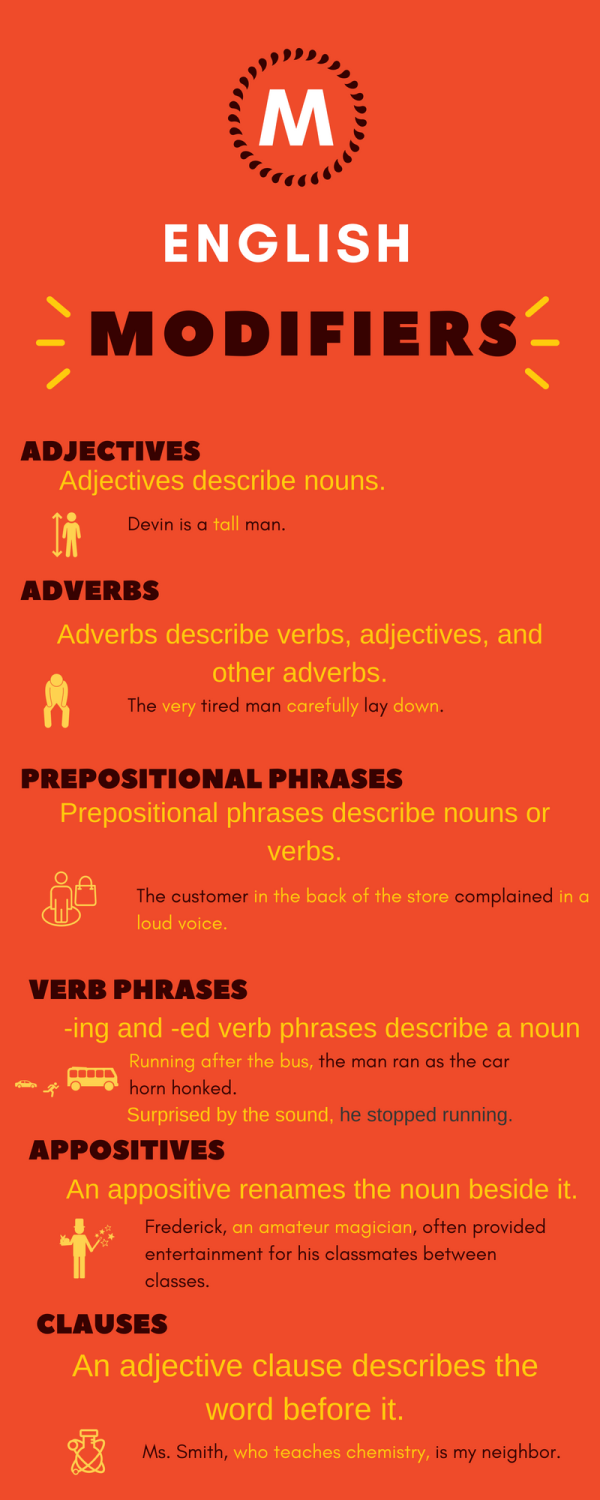
Be a Moderator for a 2019 EVO session
Every year, the Electronic Village supports professional educators who have expertise to share. Follow this link to take advantage of this opportunity for professional growth.
Modifier Infographic
I have been working off and on, more off than on, on a video about modifiers. Much like when I was working on my dissertation, almost anything was more attractive than working on my dissertation, I have been procrastinating on this video. To give myself the illusion I am making progress, I made an infographic about modifiers. I made it on Canva. I find that Canva has enough of the tools to make an infographic for me to make a serviceable infographic for free.
The infographic considers 6 types of modifiers, describes them, and provides examples.
Here is the infographic. Ideas for improving the infographic are appreciated.

A random worksheet critique
I have been doing some thinking about worksheets. I occasionally used worksheets I found online and in a few instances regretted it. Curating worksheets can be time-consuming, but it is necessary. I decided to examine one pretty much randomly focusing on a grammar or grammar/writing worksheet. I downloaded the worksheet in the image to test out a set of guidelines I found online. I purposely am not sharing the source of the worksheet to avoid implying this worksheet is representative. Furthermore, I believe there is no identifying information about the author or source in the image. Furthermore, my critique is based on my former teaching context. The worksheet maker obviously made the worksheet for a different situation. With these cautions in mind, let’s proceed.
The worksheet meets several of the suggested guidelines. When I exam the worksheet, I see that it seems to follow the formatting elements of the guidelines except for lacking a space for the student to write his or her name. It passes on the formatting level and looks good.
So far, so good. The instructions for use are clear. However, the grammar explanations pose problems.
The grammar explanations differ from those used in my context. The writer uses two different kinds of conjunctions without distinguishing between them. But is a coordinating conjunction; though is a subordinating conjunction. That may not be a major problem for some users since the writer of the worksheet is writing about conjunctions. However, the distinction between subordinating and coordinating conjunctions is important for the setting I taught in.
Also, I would not use the sentence ending though for my lessons. The though at the end of the sentence “I like vegetables. I don’t like carrots, though.” is an adverb and not a conjunction. Conjunctions join words, phrases, or clauses. The directions ask students to incorrectly think of the sentence ending though as a conjunction if they follow the model.
Though may signal a relationship between sentences, but it is not a conjunction in these sentences. If I were teaching a reading class, I would certainly point out how the sentence ending though signals a relationship with the previous sentence, but then so do repeated words, pronouns, and synonyms.
Second, the explanation includes the information, “”But” is generally in the center of a sentence, though it is often used to start one, which is incorrect.” This is not correct because but is fine at the beginning of a simple sentence. There is no grammar rule prohibiting using but at the beginning of a sentence. This use of but is a stylistic issue.
My critique of what looked at first to be a promising worksheet indicates it would not be one I would feel comfortable using for my writing class or for a grammar class. It combines two types of conjunctions (coordinating and subordinating) into one category: conjunctions. It uses though as a sentence ending conjunction where it functions as an adverb.
When curating worksheets, we need to be conscious of our own needs and carefully exam the worksheet for consistency with our lesson objectives and context. Obviously, this requires time and effort, but we don’t want to use a worksheet that sabotages our lesson objective or that we have to unteach in class. The damage may have already been done.
Some thoughts on worksheets
I have been considering how I used worksheets as I read some criticisms of using worksheets by David Didau and Mark Barnes. These criticisms nagged at me, made me feel like maybe I wasn’t such a good teacher. Worksheets, aren’t they so like 20th century? Aren’t they just reinforcing the industrial model of education? At the risk of sounding defensive, I have a few ideas about worksheets that while not directly addressing the critiques argue for their usefulness.
I did a little research and found an ELT article about worksheets on tefl.net. The article aimed at teachers provides a list of reasons why a teacher might choose to use worksheets, includes a guide to good worksheets, and categorizes the kinds of worksheets.
The kinds include:
- Matching Worksheets
- Word Scrambles Worksheets
- Jumbled Sentences Worksheets
- Sorting Worksheets
- Multiple Choice Worksheets are basically quiz-type exercises
- Gap Fill Worksheets where students insert the right words in gaps in the text
- Word Puzzle Worksheets include crosswords, word search, and word maze
- Labeling Worksheets where students annotate an illustration
Yes, I have used each type at least once and many several times. But these were not the types of worksheets I relied upon in many of my classes. I developed my own worksheets for my classes that sought to have my students engage more actively and at a deeper cognitive level. Many of the above-listed types of worksheets involve primarily memory and manipulation. I sought to do more.
I went beyond these types of worksheets by making worksheets that asked students to do more than one activity to complete the worksheet. For example, in my reading classes, I might ask the students to correct some incorrect information. To do this, I would take some sentences from the reading and change some sentences to have incorrect information such as a year, make a positive statement negative or vice versa, or attribute a quote to the wrong person. Next, on the worksheet, I might have the learners map cause and effect relationships or identify text structures for paragraphs. If the text contained a problem solution structure, I could have the students identify each and identify any evaluations of the solutions. I might also ask the students to provide their own evaluations of the solutions especially if the text failed to provide any.
I believed these types of worksheets focused students on real academic reading activities and could lead to discussions not just of what the correct answers were when there were correct answers. They also could lead to discussions about effective ways to find information in a text, identify relationships, and locate evidence for opinions either of the author or for their own use. These types of activities required engaging the text. They were not memory based, and to my mind at least, they reflected real-world demands my students would face in the academic studies they would pursue.
Worksheets used for fillers or make-work cheat learners of important learning opportunities. As a flipped learning teacher, I found that well-constructed worksheets enabled differentiation and provided opportunities for formative assessment. Worksheets used for sound pedagogical purposes can scaffold learning. They can provide learners with additional opportunities for interaction with the content or language. Furthermore, well-constructed worksheets can help in developing concepts or correcting misconceptions. Teachers should not shy away from using worksheets because of criticism. Instead, take the criticism seriously and consistently question how the use of worksheets maintains a principled pedagogy.
Reflections on my flipped learning journey (part 1)
I flipped my first class about 6 years ago. I flipped because I was dissatisfied with my teaching and my approach to the classes I taught. I got the idea from an article I read in the popular press. I went about it doing the best I could from what I understood about the flipped classroom. When I went online to find out more, most of the discussions centered around video. The discussions were about how to make videos, what were the best applications, what were the best strategies, and how to make them available to the students.
Because I started flipping with little preparation (definitely not the best approach), I found myself scouring YouTube for videos I could use for my class. I found some videos about the more common topics like fragments, run-ons, and parts of speech, but I had to make videos when nothing appropriate was available such as for the different types of paragraphs like cause and effect and comparison or contrast that my students were expected to write. Curating videos meant spending a lot of time looking at poorly made videos, good quality videos teaching incorrect grammar like one that mistakenly identified fragments as run-ons and vice versa. I also found it difficult to find videos that matched some problems my students were having. Admittedly, I also found some gold. The videos on Jennifer ESL helped me out on several occasions.
I tried challenging my students to make videos, but after a couple of semesters with poor participation and only one good video, I abandoned that. I used the good video for my class until my last year teaching the class. Students, I think, faced the same issues I did. The models for good videos were few, and the time needed to make a good one took time away from other things they needed to do.
After a couple of years, I divided my video making into three categories: how-to videos, just in time videos, and core videos. How-to videos showed students how to do something such as make a timeline for a reading using Google Drawings. When an issue arose in class like when before, after, and until are used as prepositions or as conjunctions, I addressed the issue with a quick video sometimes using Explain Everything on my iPad, sometimes using Quicktime or Camtasia on my computer. The core videos took longer to make since they were designed to be used again and again. They were about topics the students needed to know in order to do well in the class.
As I worked at becoming a better flipped teacher the emphasis changed from the flipped classroom to flipped learning. Discussions about flipped learning became more pedagogically focused. This change led to deeper explorations of learning and how to enhance it. They caused me to continually reevaluate my practices. As research emerged about flipped learning, it reaffirmed what I was already experiencing in my classes. Students engaged in class activities with much more enthusiasm, discipline problems were minimal, student participation increased, and student performance on assessment measures improved. In fact, for one class, I had to redesign the exams because the existing exams were too easy now.
I worked at incorporating what I learned from other teachers and my practice into improving my classes. I expanded my understanding and use of active learning, project-based learning, and formative assessment. I spent more time listening to and observing my students and engaging them as human beings and not just as students. I better understood the heroic efforts some students were making. Furthermore, I was able to spend time and nurture students who might have fallen by the wayside before.
I have retired recently, and my biggest regret is that I did not discover flipped learning much earlier in my career. It helped me get closer to being the teacher I always wanted to be.
Preparing for Note Taking in Listening
Part of my communication class involves working on note taking. Note taking presents several challenges. We need to capture the main ideas and key points and record them. I have experimented with and exposed my students to different practices including the Cornell system and mind-mapping. But I often had students trying to take notes before I prepared students for what to listen for.
In order to address that problem, I have experimented with inserting questions into a video. I would use the caption tool on MovieMaker, for example, to insert questions at certain points in the video when a speaker signals something like topic or support. I currently use Angela Lee Duckworth’s presentation on grit as the practice video. The video here is her TED talk. I respect the copyright gods too much to put my version up. Suffice it to say, I insert questions into the video at points I identify as key points.
However, I thought the questions were not sufficient, so I devised an exercise in which the video would be played three times: the first time for content, the second time to identify the elements of the speech, and the third time to identify the language used to identify the elements of the speech. The handout looks like this.
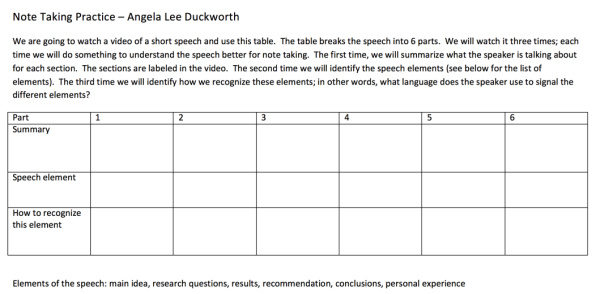
The challenge in note taking is to record the pertinent and important information. By working with the students to identify organizational patterns like problem and solution, time order, and cause and effect, we can help them anticipate where important information occurs. This activity seeks to make students more aware of signals that a speaker might use to indicate important information is coming and what kind of information will come.
Since TED talks rarely include digressions, I need to find other talks to help students identify when a speaker is making a digression, and they can relax in their note taking.
Pronouns and Reading
I haven’t read up on this, so maybe I am way behind the curve on pronouns and reading. I find my students experience difficulties in tracking pronouns to their referents or antecedents in reading. One of the first activities I do at the beginning of the semester is to take some paragraphs from our first reading and ask students to identify the referent for the pronouns. In the following screen shot is the first paragraph of the reading taken from Focus 4: Reading and Vocabulary.
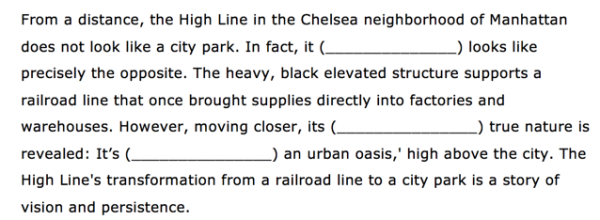
About half the class found the exercise difficult either taking a great deal of time with it or identifying the wrong referent. It could be that referents for it are more difficult to track than gendered personal pronouns. However, the difficulties indicate possible areas affecting reading comprehension that need attention.
This type of activity can be easily replicated with almost any text where the writer uses pronouns in the text. It forces students to slow down and process the text and gives the teacher an idea of where text misinterpretation can occur. This type of activity along with circling the referent and drawing lines from the pronoun to the referent can help students understand how the text is put together. In addition, it can help teachers assess which student find this difficult and need more work with identifying the referent for the pronoun.
Rewordify
I was listening to a podcast, EdTech Take Out, and at the end of the show, each of the two podcasters mentioned favorite new tech products. One of the podcasters mentioned Rewordify.com. I decided to check it out because the review indicated that it might help my reading students.
I did check it out. It looks promising enough that I will share it with my students this semester. Rewordify.com takes a text and rewords the difficult words into either simpler words or explanatory phrases. Here is an example from the Custom House chapter of The Scarlet Letter by Nathaniel Hawthorne.
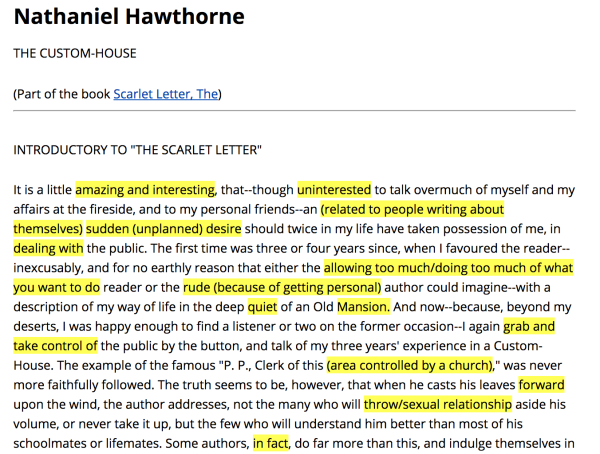
Each of the highlighted words or phrases replace more difficult vocabulary items. The difficulty calculations are based on the Corpus of Contemporary American English word frequency calculations. When the highlighted area is clicked on, the original word or phrase will appear.
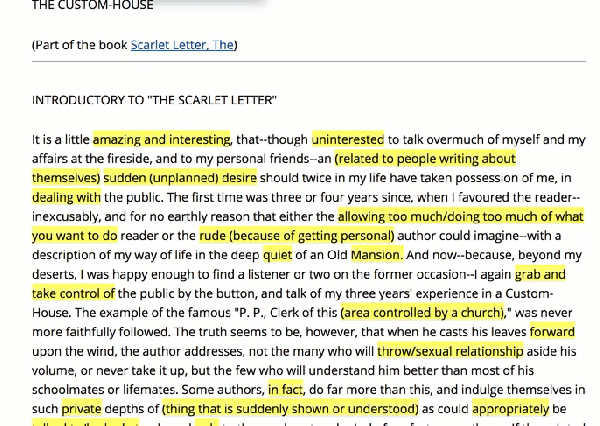
We can also get information about the text this is entered including reading ease and vocabulary density. We can find this out by looking at the top of the page which immediately provides information about how many difficult words are in the reading. If we choose Stats,
we can find out more information about lexical density and readability.
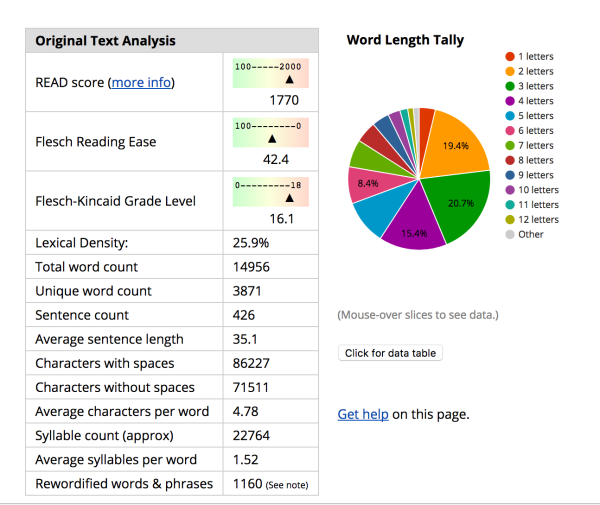
Looking at the stats reinforces the initial impression that this would be a very difficult text for English language learners. Print and Learning Activities give us a menu of different resources to use including vocabulary lists and quizzes.

I haven’t tried these out yet, but I did do the vocabulary list with definitions for the first reading my class will do.
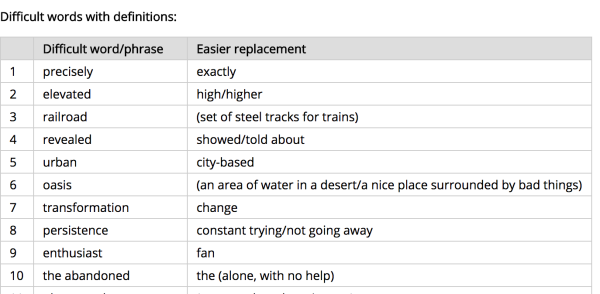
The site provides educator assistance if you choose Educator Central at the top of the menu items. Educator Central looks like this.

As I have said, I haven’t used this site, but it looks very supportive for the users both teachers and students. I haven’t decided how to use this site for my class but plan to use it. If you use it, please let me know what your experiences are.
Kahoot
Flipped learning requires constant formative assessment. Many of these assessments occur in class with the teacher looking on. Other assessments involve checking work with the class, getting feedback through exit tickets and asking for it. But sometimes, I like to switch things up a little with a game-like activity. I use [Kahoot] (https://kahoot.com/) a game-like assessment activity.
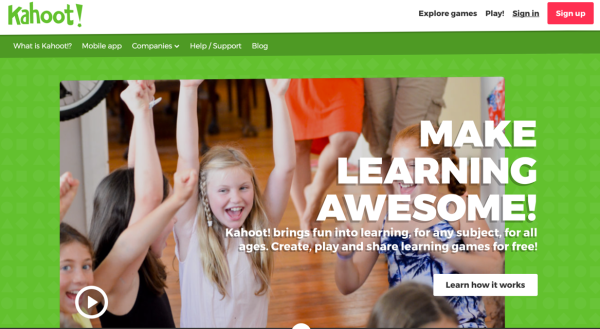
Kahoot is a free online application that can be used to create quizzes, surveys, or open ended questions. I have created 25 Kahoots for my reading and for my writing classes. I generally make multiple choice quizzes. In making the quizzes, the creator can add images and even video (though I haven’t done that yet) to the quiz. The process is pretty straightforward.reading and for my writing classes. I generally make multiple choice quizzes. In making the quizzes, the creator can add images and even video (though I haven’t done that yet) to the quiz. The process is pretty straightforward.
Students can access Kahoot on their cell phones, tablets, or laptops. They sign in and give themselves names. I don’t require a transparent name (I don’t always know who is who during the game). The questions with the choices appear on screen with the choices in different geometrical shapes and colors. Students select the shape of the correct answer. What makes it challenging and exciting for the students is each question is timed. The scores are recorded with the top scores reported. This continues until the quiz is finished.themselves a name. I don’t require a transparent name (I don’t always know who is who during the game). The questions with the choices appear on screen with the choices in geometrical shapes of different colors. Students select the shape of the correct answer. What makes it challenging and exciting for the students is each question is timed. The scores are recorded with the top scores reported. This continues until the quiz is finished.
For the teacher, the results can be exported to a Google Drive Sheet (an Excel like application), so teachers can examine the results. This helps because, in class, it sometimes looks like a student is doing really well only to find out later the student struggled after the first question or two. This information can be used to shape reviews.
I have found Kahoot a useful formative assessment tool as well as a good change of pace during a long semester. Students usually have access as long as wifi is working in the classroom.to a useful formative assessment tool as well as a good change of pace during a long semester. Students usually have access as long as wifi is working in the classroom.
I haven’t assigned Kahoot outside of class, but that seems to me to be a good option to explore. Here is a video introducing Kahoot.